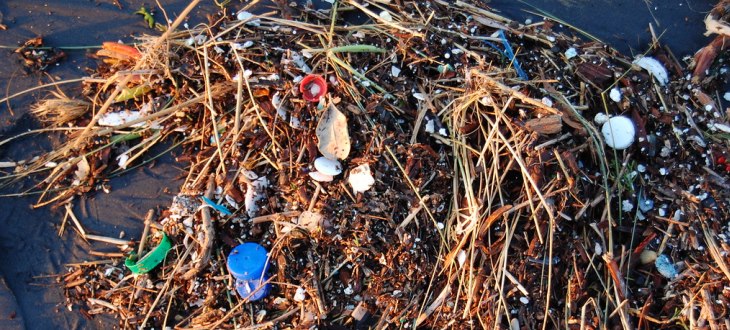The State We're In
Microplastics: invisible threat
The South Branch of the Raritan River is one of central New Jersey’s prettiest waterways. It winds through mostly rural and suburban towns with little industry. Its clear waters are ideal for fishing, paddling and wildlife watching.
Yet, a recent pilot study by watershed watchdog Raritan Headwaters Association found a virtually invisible form of pollution: microplastics, or pieces of plastic almost too small to see.
For the study, Raritan Headwaters staff members submerged fine-mesh nets in the water for an hour at a time at 10 sites along 23 miles of river. They collected more than 4,000 bits of plastic the size of a poppy seed or smaller.
Most of the tiny plastic bits were fragments of much larger plastic objects like bags, bottles, straws and food wrappers. Concentrations were highest at sites just downstream from treated wastewater discharges, but microplastics were present even at upstream locations.
It’s very bad news, since the Raritan River is a major drinking water source for 1.5 million New Jersey homes and businesses.
But this problem is not unique. Across New Jersey, the nation and the world, microplastics in waterways are increasing.
Rutgers University, the NY/NJ Baykeeper, Clean Ocean Action and the Delaware River Basin Commission are also conducting studies on microplastics and the threats they pose to aquatic life and human health.
“Scientists estimate that total daily microplastic release into aquatic environments may be as high as 8 trillion microplastics a day,” according to a Rutgers-NY/NJ Baykeeper study. “Unfortunately, water treatment plants were never designed to address this modern pollution, and so these microscopic plastics are not removed during the water treatment process.”
Where do they come from? Everywhere. From us. It’s nearly impossible to go a day without using and discarding plastic items.
Plastics that find their way into the environment don’t decompose – they just break down into smaller and smaller pieces. Microplastics even come from synthetic clothing fibers, packing materials like Styrofoam, and personal care and cleaning products with abrasive materials.
“Scientists are now seeing microplastics in the tissue of finfish and shellfish, which means microplastics have the potential to enter human food sources,” said the Rutgers-Baykeeper study.
And microplastics are in bottled drinking water. They’ve even been discovered in the soils of the Swiss Alps and the air of France’s Pyrenees Mountains.
What can be done? Here are some ways you can help!
- Keep plastics out of the water. Join organized cleanups, like the spring and fall Beach Sweeps run by Clean Ocean Action and the annual Stream Cleanup by Raritan Headwaters. Or do your own mini-cleanups along your favorite rivers and beaches!
- Use fewer plastics. Bring reusable shopping bags to the supermarket, refill reusable water bottles from the tap, and avoid plastic bottles. Seek out items with minimal or no plastic packaging.
- Support a state ban on single-use plastic bags. The New Jersey Legislature has introduced a law that would ban single-use plastic grocery bags, plastic straws, and Styrofoam containers. If passed, it would be the strictest anti-plastic legislation in the country.
- Urge your town officials to upgrade filtering technologies to remove more microplastics from wastewater.
In the absence of state legislation, many communities are taking action. On May 2, the Association of New Jersey Environmental Commissions (ANJEC) celebrated the passage of the 50th municipal ordinance to control plastic pollution.
To learn more about microplastics, visit the NY/NJ Baykeeper website https://www.baykeeperplasticstory.org/, the Rutgers website at http://raritan.rutgers.edu/rutgers-and-baykeeper-study-microplastic-pollution-in-the-raritan-river/, and the Clean Ocean Action website at http://www.cleanoceanaction.org/index.php?id=824.
And for information on preserving New Jersey’s land and natural resources, visit the New Jersey Conservation Foundation website at www.njconservation.org or contact me at info@njconservation.org.
About the Authors
Alison Mitchell
Co-Executive Director
John S. Watson, Jr.
Co-Executive Director
Tom Gilbert
Co-Executive Director, 2022-2023
Michele S. Byers
Executive Director, 1999-2021
View their full bios here.
Filter
Get The Latest News
From The Garden State
In the
News

